“Success has many fathers,” the old saying goes, “while failure is an orphan.” The origins of this aphorism are unclear, but the Parmigiani Toric Hémisphères Rétrograde, which took home the prize for Best Travel Time Watch at the 2017 Grand Prix d’Horlogerie de Genève (GPHG), can certainly be deemed a success, and the “many fathers” concept is a truism when one considers how the timepiece came to be, and the diverse artisans involved. In this feature from the archives, we trace the origins of the watch through each of the five workshops within the Parmigiani Manufacture.
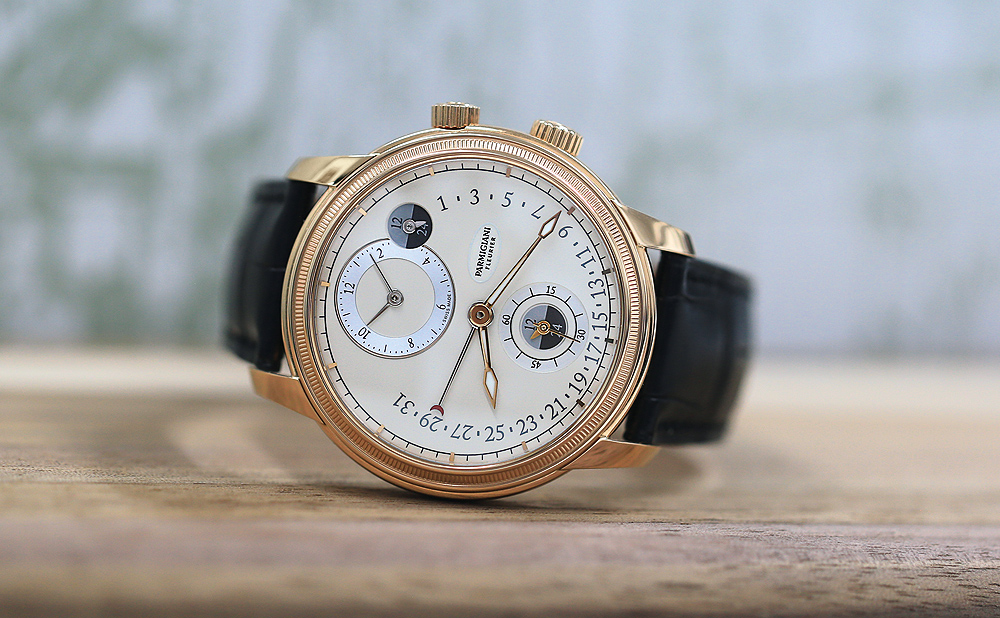
We get lots of watches to review here at WatchTime HQ, and we visit a lot of watch factories and ateliers, but it’s very rare that we not only get our hands on a timepiece that won at the Oscars of watchmaking but also have the chance to wear said watch while touring the horological heartland of Switzerland to visit the workshops from which its various elements emerged. That is precisely the opportunity that I had this spring, immediately following Baselworld 2019, when I wore the Toric Hémisphères Rétrograde on a comprehensive tour through all five of the specialized Swiss firms that make up the amalgam known as the Parmigiani Watchmaking Centre – established by Parmigiani’s parent organization, the Sandoz Family Foundation, in its quest to bring the brand, founded by namesake Michel Parmigiani in 1996, to vertically integrated manufacture status in the relatively short span of 20 years. Think of it as a watch revisiting its intriguing origin story, or perhaps a timepiece version of the old TV series “This is Your Life.”
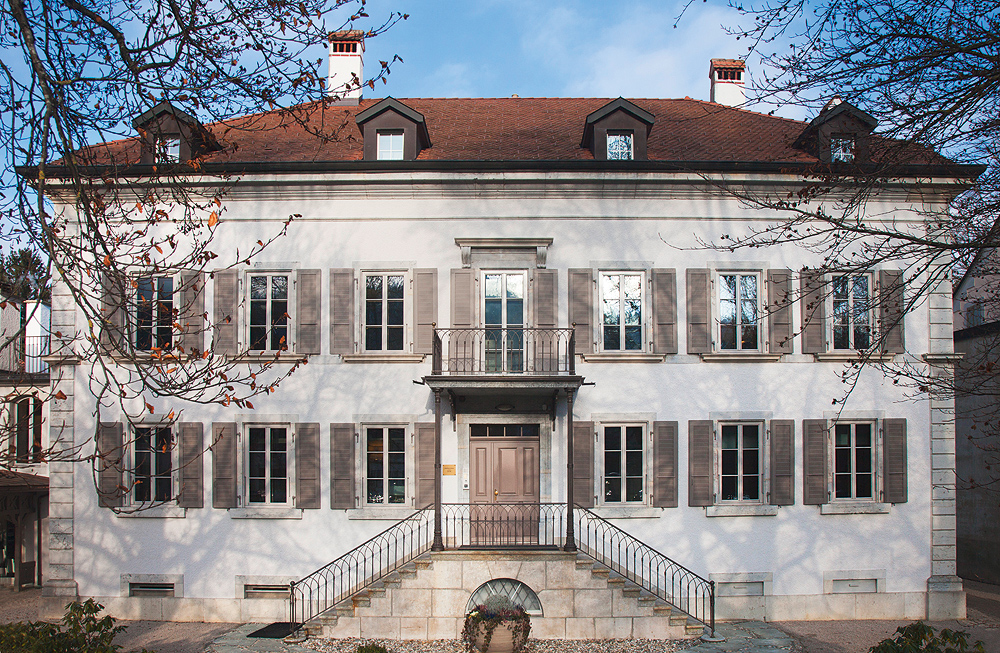
Crafting the Case
The Toric collection, which was relaunched in 2016 with the Toric Chronomètre and has grown in the years since, has its roots in the first wristwatch ever designed by Michel Parmigiani, who began his career as a respected restorer of antique timepieces. It was, in fact, a historical pocketwatch sent to Parmigiani’s restoration workshop – one that incorporated two movements inside one case, each one responsible for a separate time zone – that inspired him to develop this watch’s clever GMT complication, which is ingeniously designed to allow any two time zones to be paired to the nearest minute, even the oddball half-hour and quarter-hour zones that deviate from the standard 24 one-hour zones based on the Greenwich meridian.
Michel Parmigiani’s creative vision – and his fascination with the so-called Golden Mean principle of architectural design – can be observed immediately in the Toric’s rose-gold case, with its elegant fluted bezel that calls to mind ancient Roman or Greek columns. The case, with its diameter of 42.8 mm, has a gleaming, polished finish that accentuates its ergonomically curved surfaces, culminating in the sloping teardrop lugs that anchor the casebody to the strap and caress the curves of the wrist.
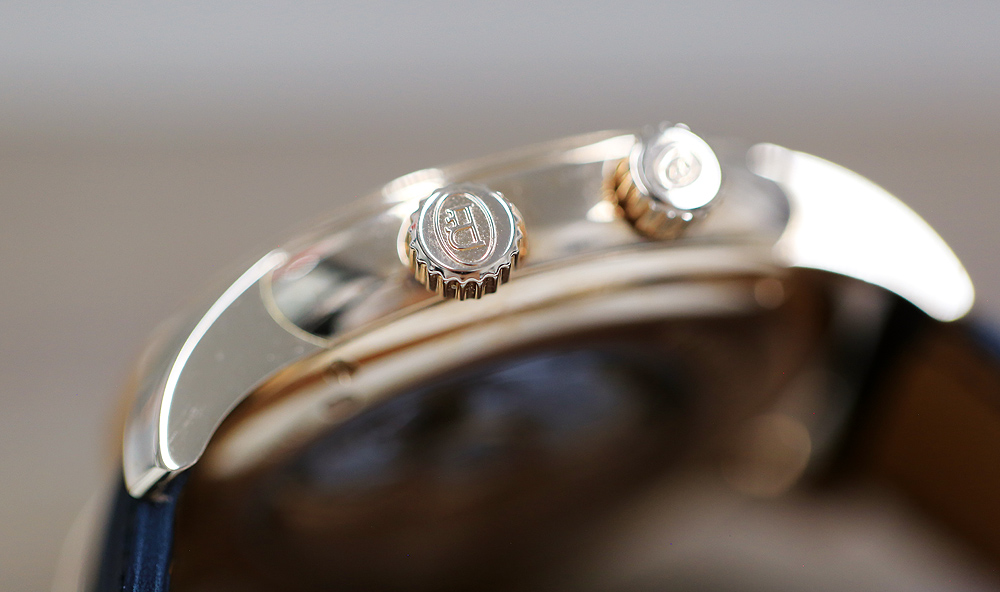
The case, like the cases of all Parmigiani watches as well as those of several other notable luxury brands that may prefer to keep that detail under wraps (and have agreements to that effect), is the handiwork of Les Artisans Boîtiers (or simply “LAB”), based in La Chaux-de-Fonds and acquired by the Sandoz Foundation as Parmigiani’s casemaker in 2000. The company’s experts shepherd each high-end watch case from A to Z, with cutting-edge, numerically controlled technology reining at the start of the process, utilizing CAD (computer aided design) software that designs each case in 3D on a computer screen and digitally controlled CNC (computer numerical control) machines cutting and refining each case component to a precision of one micron. Since the process at LAB is all about machining, not stamping, most cases, including that of my review watch, are comprised of three parts, with the lugs soldered to the case middle. These days, our tour guide at LAB tells me, prototyping of new cases begins with 3D printing, which provides the template for the brass and steel prototypes that precede the actual cases, which can be made of steel and various precious metals, including platinum, the most difficult to machine.
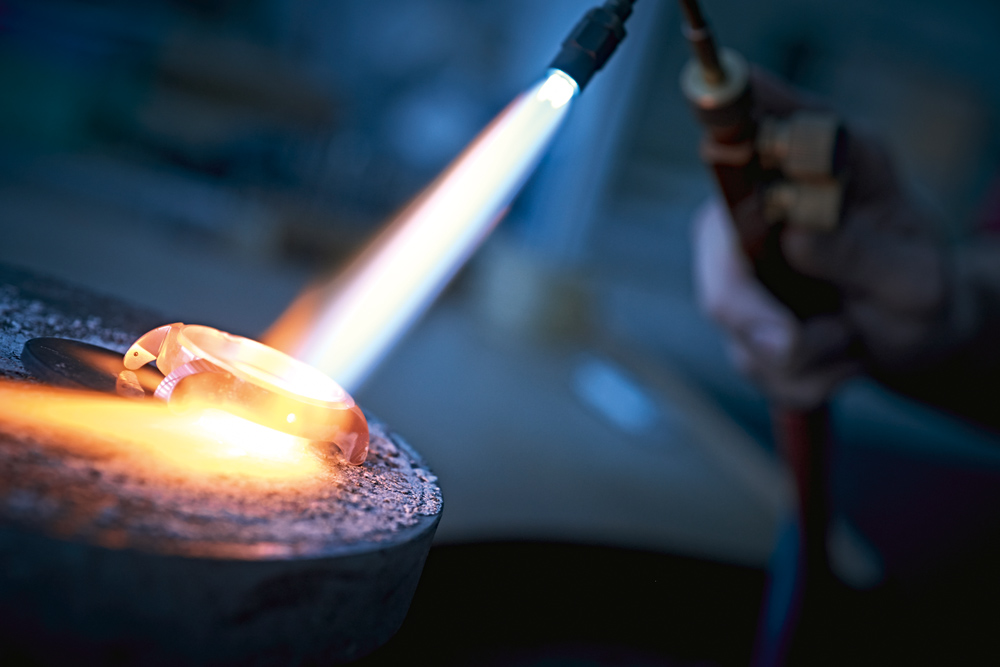
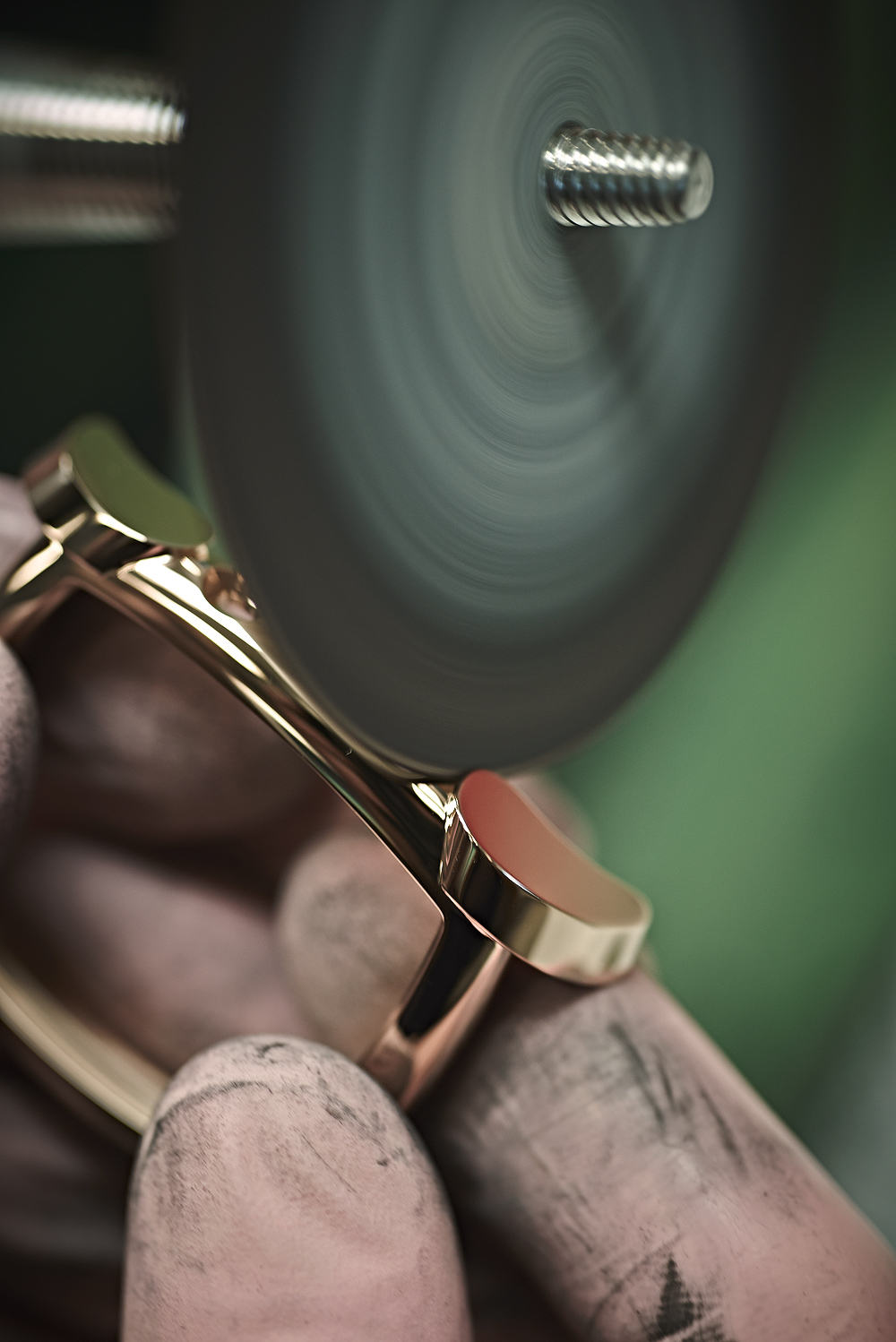
High-tech gives way to the human touch in the final, most refined stages, as the deftly trained hands of master craftsmen tend to the soldering, filing and other specialized disciplines that take each complex, meticulously polished Toric case to the finish line. Even the casemaking machinery at LAB is all made in Switzerland, in accordance with the Sandoz Family Foundation’s edict; at this stage, the few casing elements that aren’t produced in-house include the sapphire crystals, the bracelets and straps, and the rubber gaskets for water resistance. The cases are, however, tested for water resistance at the LAB facility, at a small machine that simulates water pressure at various depths, and I had the rare opportunity to have my review watch put through its pressure-resistance paces in the place where its case was born. (And yes, it more than met the 30-meter water resistance standards declared on the case – it was tested for 50 meters – and I have the certificate to prove it.)
All Around the Dial
The complex yet extremely user-friendly functionality of the Toric Hémisphères Rétrograde finds its outward expression on the grained white dial, with two central javelin-shaped hands displaying the main time zone, plated in 4N rose gold and treated with Super-LumiNova for nighttime legibility, with the smaller hands for the second time zone, on the larger of the two symmetrically placed subdials, at 12 o’clock, more subtly plated in rhodium. Joining both the 12 o’clock subdial and the small seconds at 6 o’clock are dainty round windows displaying the day-night indications for each of the two time zones. The “Rétrograde” in the watch’s name, the aspect that distinguishes this Toric Hémisphères model from previous Parmigiani world timers like the Tonda Hémisphères (I review that watch here), is the red crescent-moon-tipped central hand that indicates the date on a 240º semicircular scale with elegantly formed, highly legible numerals. At the end of the hand’s month-long journey around the scale, a spring activates that forcefully snaps it back to Day 1 at a breakneck speed too quick for the naked eye.
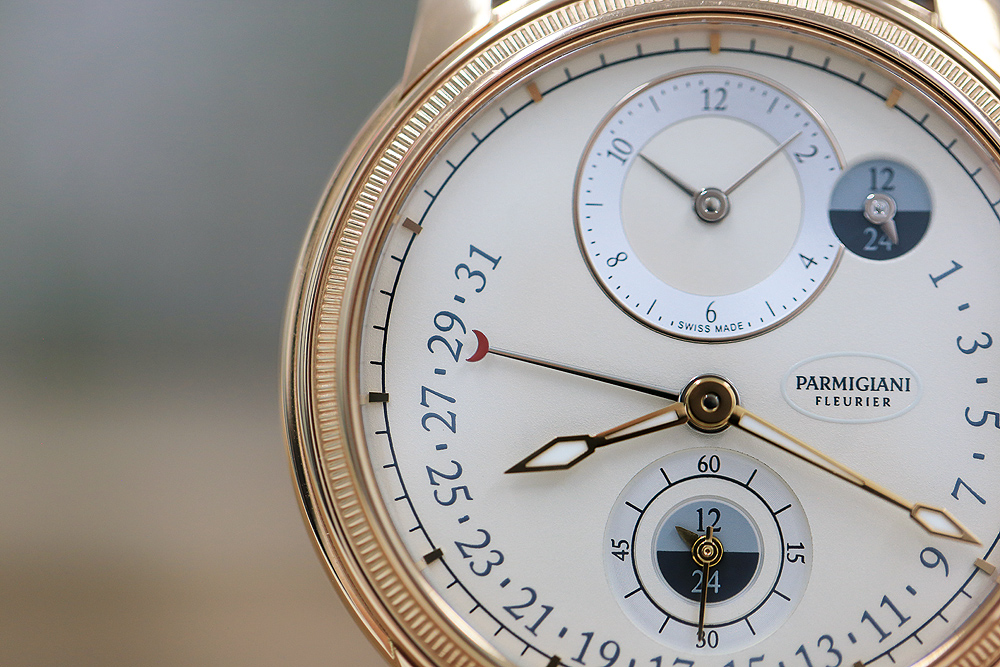
The artisans responsible for the Toric Hémisphères dial ply their trade at another firm based in the watchmaking hub of La Chaux-de-Fonds, Quadrance et Habillage, founded and added to the Parmigiani Watchmaking Centre in 2005, making it the most recent addition to the family of firms, responsible for the development, manufacture and finishing of dials, chiefly for Parmigiani but also for a handful of other discreet haut-de-gamme clients. Its master dial makers begin with a numerically controlled machine that cuts the dials, from materials as diverse as traditional brass to ultra-luxe gold to rare and fragile meteorite. To these raw disks, specialists apply surface treatments, coloring and varnishes either colorless or tinted. Final stages include the largely manual process of adding transfers and placing the 3D elements, such as the Toric Hémisphères’ rose-gilded indexes and hands. And as fate would have it, the grained white dial of the watch that accompanies me to Quadrance is one of the firm’s most special, the fruits of a manually executed process exclusive to Parmigiani, involving a single artisan rubbing silver powder onto a brass plate to produce a textured surface. The force and duration of the process, which an expert applies by hand with a horsehair brush, determines the luminosity and sheen of the finished dial and ensures that each one is subtly unique.
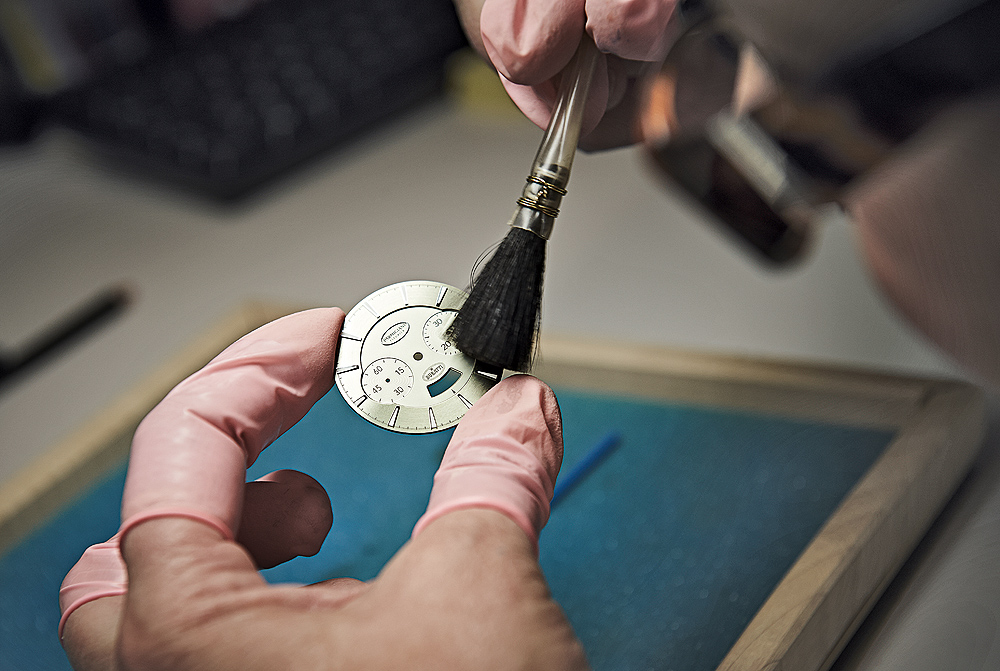
A Turn of the Screw
Delving into the movement that animates the Toric Hémisphères Rétrograde, Caliber PF 317, which peers out from behind an off-centered round sapphire pane in the caseback, prompts a road trip across Francophone western Switzerland, from the Jura Mountain villages of Moutier and Alles to the ancestral watchmaking town of Fleurier, in the Canton of Neuchâtel.
A visit to Elwin, a longstanding manufacturing firm in Moutier in the Canton of Bern, illustrates the commitment that Parmigiani has made to vertical integration, right down to the tiny screws that hold the movements together. Once the sole supplier of specialized machines to watch-industry clients, the firm since 1990 has concentrated its efforts on micro-components such as screws, using an array of traditional cam-driven machines as well as modern computerized ones, the oldest such device dating to 1818. Incorporated into Parmigiani’s Watchmaking Centre in 2001, Elwin is distinguished from other specialized manufacturers by several factors, including its policy of a single engineer overseeing all stages of a product’s process, from conception to quality control. Its current building, erected in 2009, was engineered to run its machines, now numbering a total of 33, on geothermal energy. Elwin, which makes screws from materials from steel to brass to gold, is also renowned for its prowess in constructing machines for bar turning and in developing software programs to guide them. The screws Elwin makes for Parmigiani (as well as, you guessed it, a handful of other watchmakers) are “sculpted,” in the words of its engineers, to a client’s specifications and often accessible only by special screwdrivers commissioned by said clients and outsourced to an expert maker. The only other process that takes place outside the halls of Elwin is the thermal bluing of the screws for watch movements; the expertise does exist in-house, however, used only on very exclusive projects like the restoration of antique timepieces at Michel Parmigiani’s workshop.

Escapements at Atokalpa
For Parmigiani Fleurier calibers – their cases’ screws are made at Quadrance, with the other major case components – Elwin screws are delivered to Atokalpa, in the largely agricultural village of Alle in Canton Jura. Founded in 1989 as primarily a manufacturer of machine parts for the Swiss military, its acquisition by the Sandoz Family Foundation in 2000 jump-started an evolution that would earn it, and Parmigiani, a rare distinction, as one of the few Swiss watch manufactures that makes its own balance springs, one of the most fragile yet most vital components in a watch’s movement, as well as all-important components like balance wheels (many using Elwin screws), to client specifications. Atokalpa, in fact, boasts the capability of producing in-house all the components of a watch’s escapement, or regulating organ – 20 components that range from the spring to the pallet fork to the escapement train wheel.
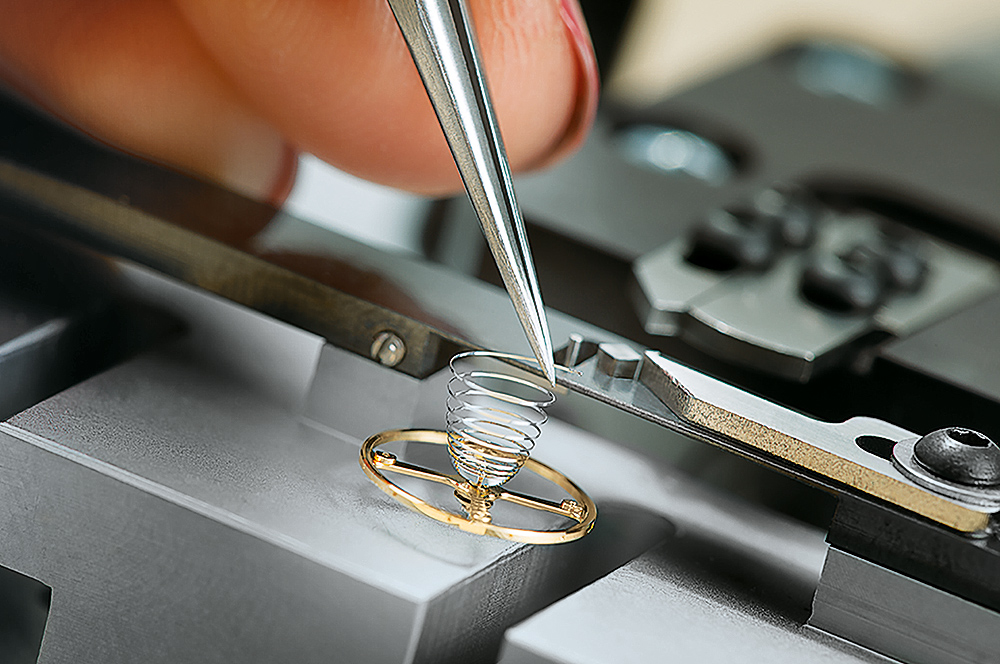
Like its fellow companies within the Sandoz Family Foundation, Atokalpa supports its nation’s industry by either making its own machines or requiring them to be built within Switzerland to rigid specifications. But the mechanized stage is only part of the process at Atokalpa, which also hosts a decoration workshop employing artisans that apply high-end finishes, by hand, to the array of components made there. For Parmigiani movements, this does not include the “showcase” decorations – like guilloché, côtes de Genève and other embellishments, which are done at Vaucher Fleurier – but does include subtle enhancements like polishing between the teeth of wheels, an intensely intricate process that involves great manual dexterity and which only three workers out of Atokalpa’s 140-person staff are trained to execute. Such a process is more functional than aesthetic, reducing friction and thus surely contributing to the rate performance of the Toric Hémisphères Rétrograde and the smooth motion of its retrograde hand.
Visionaries at Vaucher
If a watch is using a Vaucher movement, my hosts at Vaucher Manufacture Fleurier tell me in no uncertain terms, that watch is essentially using a Parmigiani movement. A bold statement but a defensible one, as this high-end atelier was created in 2003 by the Sandoz Foundation as the flagship of the Parmigiani Watchmaking Centre, with 150 of its 200-plus employees plying their trade primarily for Michel Parmigiani’s eponymous watch maison, while also providing modules as well as complete movements to an impressive and eclectic list of brands, chief among them La Montre Hermès, whose parent company Hermès International is a part owner. (Part of the arrangement, as many Parmigiani enthusiasts know, are the comfortable, meticulously crafted Hermès alligator leather straps that are exclusively provided for the watches, like the shiny ebony wristlet that securely fastens the Toric Hémisphères Rétrograde to my wrist; while not a product of any firm within the Watchmaking Centre, the straps are sourced from an Hermès leather atelier within Switzerland.)
Established in a town with a long history of watchmaking and whose other prominent horological denizens include Bovet, Chopard and Richemont’s movement-making nerve center ValFleurier, this is where my Toric Hémisphères Rétrograde completes its spiritual journey from an embryonic array of highly specialized components to a full-blown timepiece that is more than the sum of those parts.
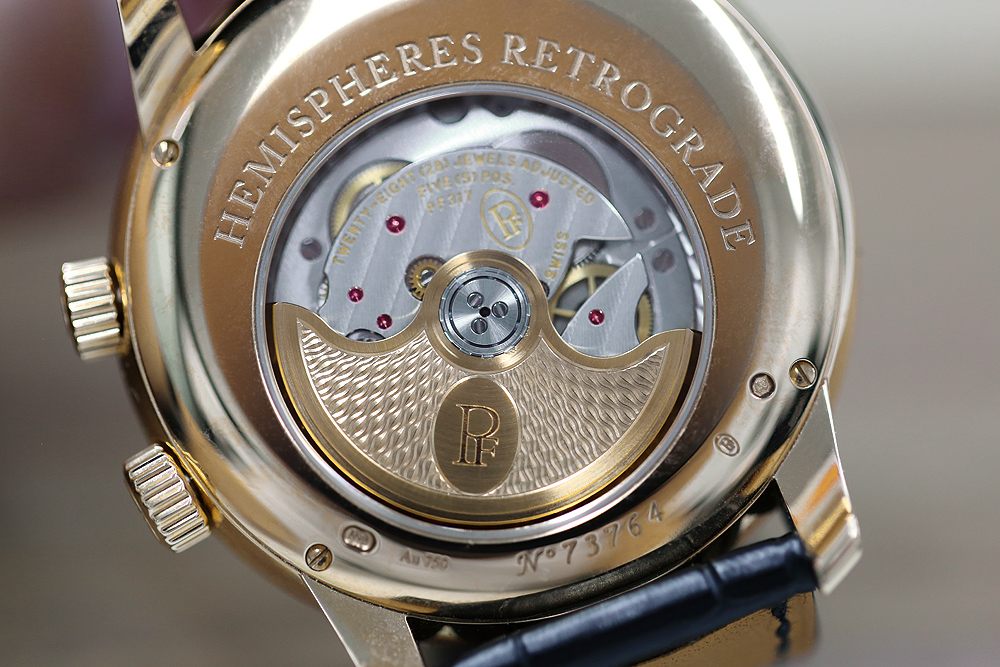
The enterprise that would be spun off as Vaucher Manufacture Fleurier began with Sandoz’s initial investment in the Parmigiani brand in 1996. The Vaucher name and tradition, however, goes back to the 18th century, when the Vaucher family gained renown as the first small-scale watchmaker in the Swiss village of Fleurier, training many apprentices in the horological arts, including Ferdinand Berthoud, who with England’s John Harrison would become one of the fathers of modern chronometry. The firm built Parmigiani’s first groundbreaking movement, Caliber PF 110, with its unusual tonneau shape and nearly unprecedented eight-day power reserve, in 1998 and its first fully in-house-made automatic caliber, the PF 331, in 2002.
The movement inside the Hémisphères Rétrograde descends from that Caliber family, incorporating a module that is indexed to the main movement to govern the second time zone. Its ingenious design allows this module to be disengaged from the main movement by pulling the crown at 2 o’clock on the case, allowing the wearer to independently adjust the second time zone on its own subdial (again, in a manner much more precise, and intuitive to read, than most traditional GMT functions, which can only be set and coordinated in one-hour increments); pressing this crown back into the case re-engages the module and thus re-indexes the current time with the home or reference time so both can be set simultaneously. (Needless to say, after more than a week away from home in Switzerland, such a complication proved to be a useful one indeed.)
With more than 33 (and counting) manufacture calibers produced at Vaucher over 20-plus years, it is of note that Parmigiani is the only watchmaker that partakes of all the more than 50 horological disciplines that Vaucher offers in-house – skills that include developing 3D printed prototypes; laser-cutting of bridges, plates and other components, from brass and German silver, on CNC machines; cutting and setting of hands, which are also made on the premises; machine-setting and hand-setting of synthetic rubies, and manual and machine-assisted finishing of components. Patience is a virtue in the birth of a Parmigiani movement, which can take up to five years to bring from idea to fruition – one year in the design stage, another in prototyping, an additional year in testing and a final two in industrialization.
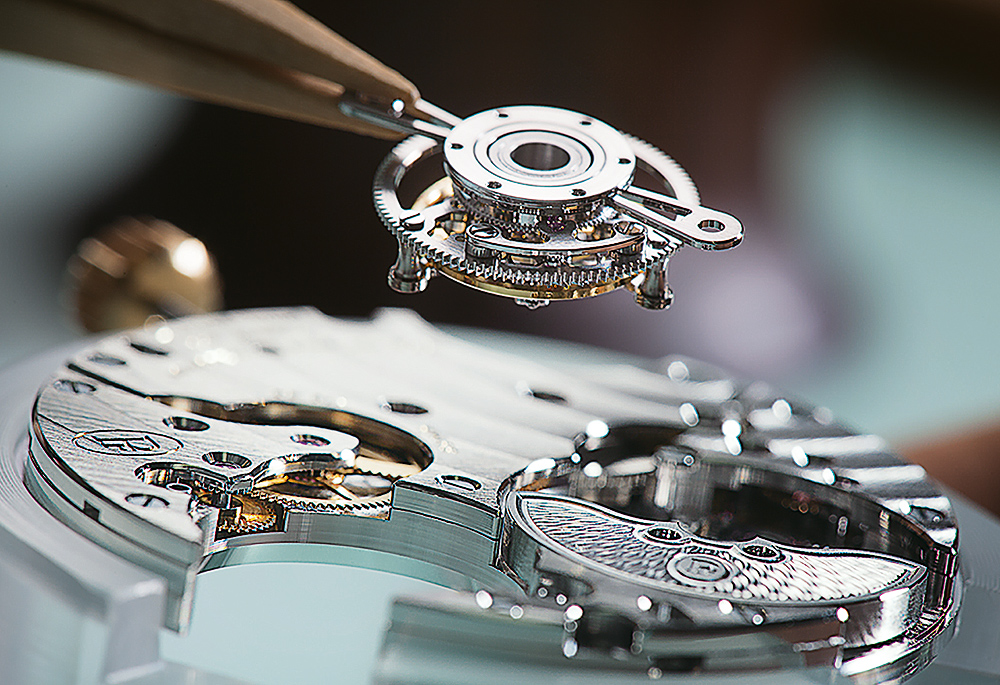
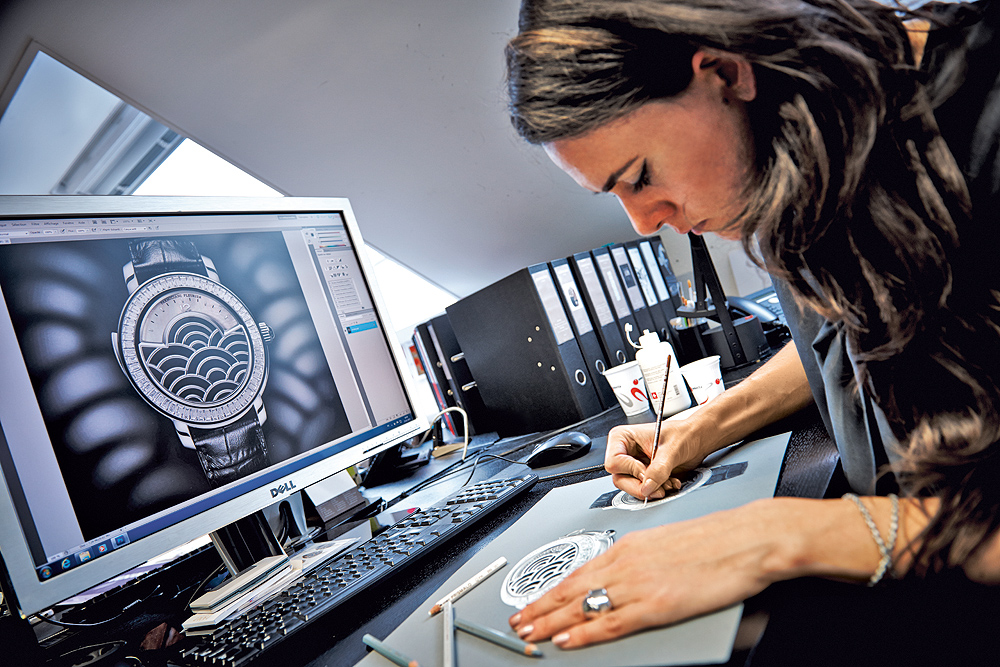
The technical savoir faire is, of course, only part of the Vaucher package. The decorative arts offered by the atelier include Vaucher’s own distinctive styles of côtes de Genève and perlage that enhance Caliber PF 317’s mainplate and bridges and the hallmark barleycorn guilloché that adorns its solid gold oscillating mass, which supplies the movement with its impressive 50-hour power reserve, stored in two series-coupled mainspring barrels. The entire ensemble, including the Atokalpa-provided escapement oscillating at 28,800 vph, is tested on one of two CLA (Clinical Laboratory Automation S.A.) machines for chronometric accuracy; the manufacture was not only the first in Switzerland to use these high-tech devices, it helped develop them as well.
While other watchmakers across the spectrum of modern haute horlogerie have benefited from the work of various companies within the Parmigiani Watchmaking Centre, it is the award-winning timepiece on my wrist, and its dozens of brethren in the Parmigiani Fleurier portfolio, that represent the purest and most well-rounded expression of their collective talents and, of course, of the creative vision of Michel Parmigiani, the watchmaker at the center of it all. And according to my hosts at Vaucher, the march toward full vertical integration continues, with integrating gem-setting into cases the likely next step, while Vaucher’s four-year apprenticeship program produces the next generation of watchmakers to bring the brand founder’s horological dreams to ticking life – and perhaps even to bring more GPHG prizes home to Fleurier.




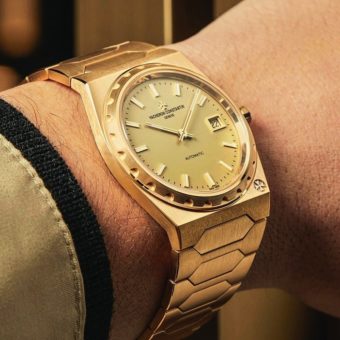
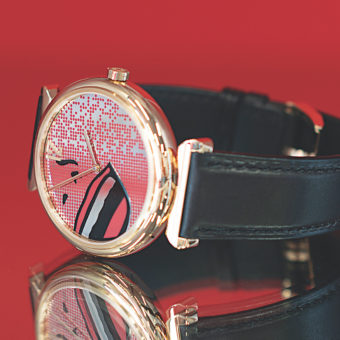
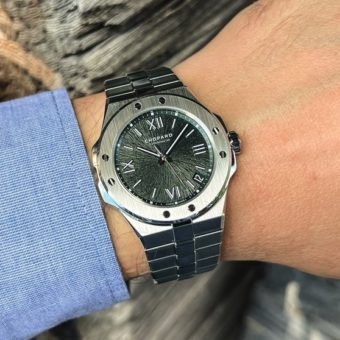

This is a great article to re-read as a constant reminder to oneself, what to aim for in watchmaking, even if one never reaches such heights.
I have collected important timepieces for around 40 years and had lost some interest in recent times for wont of pieces that touch me (WatchTime magazine published an article of my collection in June 2005). This watch turns the tide. I hope it is available and not a sold-out limited ed. The price would have been useful.
While this review certainly does a fine job of covering the merits of the Hémisphères — both generally from its roots in the Tonda (which I own) to the award winning Toric Rétrograde (which I covet), there is no mention of Agenhor or what work they did on it or what module by Agenhor was used for the Rétrograde… I mention this because Agenhor gives themselves credit for contributing to its success. (See http://agenhor.ch/en/company/ — their list of GPHG awards includes Parmigiani Toric Hémisphères Rétrograde.) My hunch is that Agenhor’s retrograde module was used for the hand date function. In my own Harry Winston Premiere Bi-Retrograde, I was sent a copy of the Agenhor bi-retrograde by Wiederrecht’s son, Nicolas.
Great article! How I would like to visit all the workshops myself!
A fascinating article about a beautiful watches birth!